Hey, Team Titleist!
For several years now, Titleist Brand Ambassador Justin Thomas has asserted himself as one of the very best players on the planet. Justin is a major winner and a former FedExCup champion. He's a perennial member of U.S. Ryder Cup and Presidents Cup teams, with 14 PGA Tour wins under his belt. And at 28, he hasn't even reached his prime.
Justin possesses a rare mix of talent, technical precision, mental toughness and competitive drive. He also has an ace up his sleeve – his coach and father, Titleist staff member Mike Thomas. Mike taught Justin how to play and guided every step in his rise to the largest stages in competitive golf.
We wanted to know more about Justin's game and the man who helped to shape it. Mike and Justin were kind enough to let us sit in during a recent practice session, so check out the video above and read on, as we share an exclusive look inside the ropes with one of the game's finest duos.
Q: Mike, Justin's latest victory was an amazing one at THE PLAYERS in 2021. His Sunday performance was unforgettable, hitting 17 of 18 greens in regulation at TPC Sawgrass. At the time, Justin called it the best ball-striking round of is life. But it was a very emotional time, too, as you had recently lost your father, Paul. What do you recall from the victory and how was Justin able to elevate his game under the difficult circumstances?
Mike Thomas: Justin really likes that golf course, always has. He had a good week of practice leading up to The Players, and just kept getting better everyday. Didn't have a great putting week, but Justin's ball striking was great. While my dad's passing was still relatively recent, we didn't talk about it much that week, but after winning, that emotion came out in me of all that happened.
Q: In many sports, it's said that you have to play with emotion. But in golf, the perception is that you have to stay calm and even-keeled. Can emotion help you on the golf course?
Mike: No doubt, Justin plays with a lot of emotion. It's gotten him in trouble a few times - haha. It's not the emotion to get up and tackle someone, or dunk on another player, but the emotion of total focus and commitment to the shot at hand, and the emotion of getting on a positive roll on the course.
Q: Your dad played a huge role in the Thomas family. Can you talk about the legacy that you and your dad share in being PGA Professionals and what the game has meant to you?
Mike: My dad was an old school player and club pro. He played in three majors, a number of tour events and champion tour events, while serving as a PGA Professional. In addition to running his golf shop, he gave a lot of lessons, and I just hung around the club pretty much every day. I would play and practice each day, and also work there once I was old enough. The legacy he left me was a passion for both the game, and the business of golf. Golf has been a big part of our family now for three generations and it certainly has been good to us.
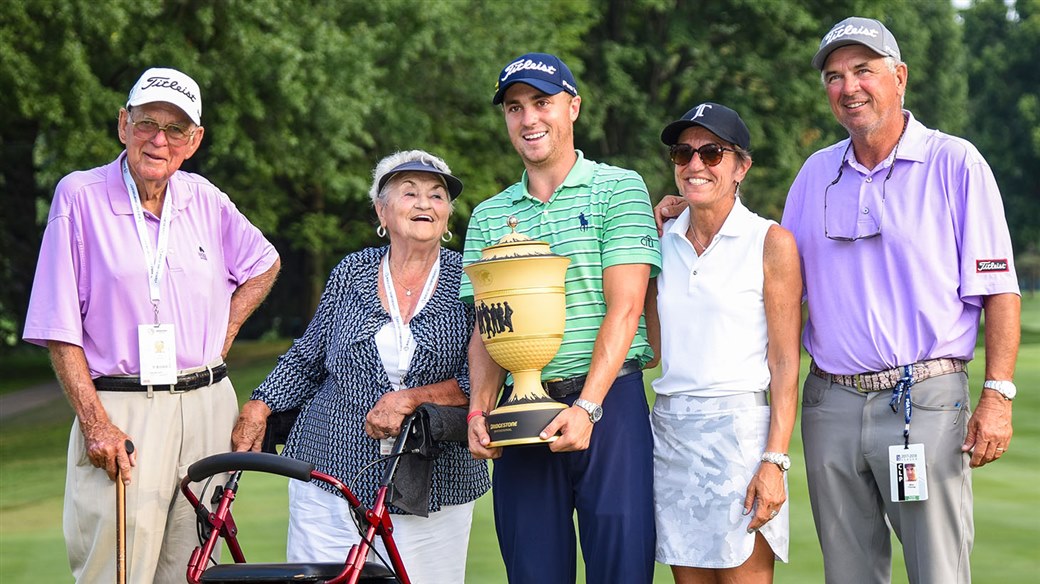
Justin (center) celebrates his victory at the 2018 WGC-Bridgestone Invitational with (from left to right) his grandfather, Paul, grandmother, Phyllis, mother, Jani and father, Mike.
Q: Did you introduce Justin to golf the same way your father introduced you to the game?
Mike: Yes, pretty much the same. Justin was hanging out all day while I worked, which is what I did. We were both literally at the club every single day. Being there so much exposed us both to the game, all the members, and everything. That was great about golf. Difference was, my dad pushed me a lot, while I never pushed Justin to play or practice. He was driven to do it on his own every day. I didn't need to be pushed either, but my dad pushed me anyway.
Q: Does working together present any challenges to your relationship as father and son? Or is golf such a part of the equation that it’s a natural extension of that relationship?
Mike: We have always worked well together for one reason. I am a friend, not a parent FIRST. Secondly I am a coach, lastly I am a parent. Our whole goal is to A) keep things fun, that's being a friend, and B) to focus on getting better, that's being a coach. I am only a parent when I need to address outside things, which is less and less often.
Q: When Justin first began playing, was his talent immediately apparent to you? Did he do things that other kids simply couldn't? Or did he have more drive, a stronger desire to work at it?
Mike: All the above. He always hit it very solid at a young age. He also always enjoyed working on his short game, which most kids don't. Lastly he was extremely driven. He definitely outworked all around him. That served him well as he was a very small child until about age 16, and was usually one of the shortest hitters in his fields.
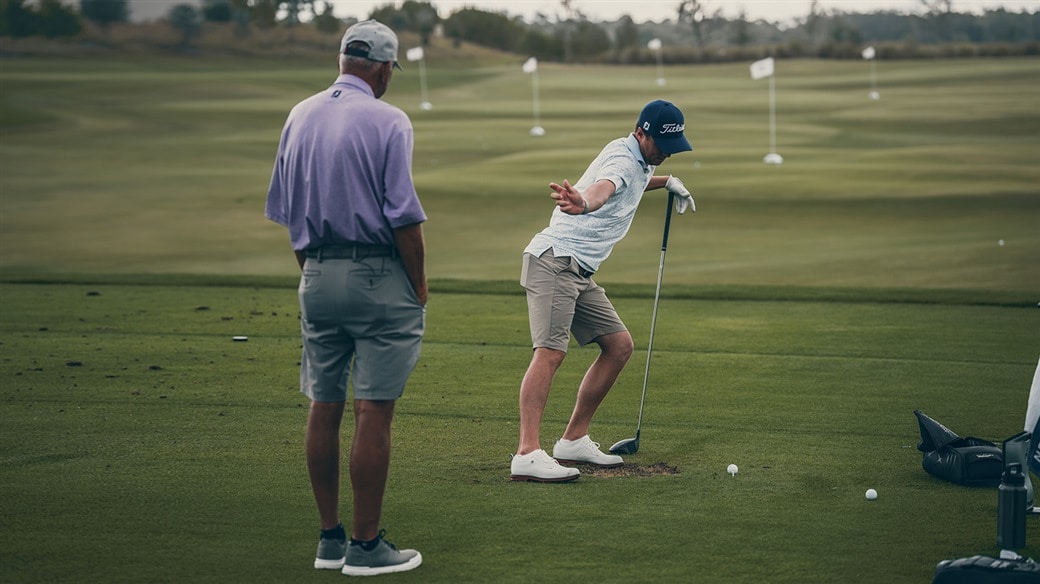 Q: In teaching, many have cautioned that when you have a player with talent your main goal should be, 'don't screw them up". Is there more pressure teaching someone with a lot of talent? How do you decide which elements in their technique need to be addressed and which ones are important idiosyncrasies that should be leave alone?
Q: In teaching, many have cautioned that when you have a player with talent your main goal should be, 'don't screw them up". Is there more pressure teaching someone with a lot of talent? How do you decide which elements in their technique need to be addressed and which ones are important idiosyncrasies that should be leave alone?
Mike: No doubt, teaching better players comes with a unique pressure. If you tell a good player to do something, they have the talent to do it, so it better be the right information. And certainly, a good teacher will identify things that are unique to an individual's swing. If it doesn't cause any harm, they know to leave it alone.
Q: Do you ever find yourself passing lessons on that your father shared with you?
Mike: Yes, I would say we're both very old school, and our teachings are very simple. I also still use some drills, etc. that I used to see him use on others. A line I always use with my students is... "golf is already hard, it's my job to make it simpler".
Q: Specifically regarding THE PLAYERS in 2021, do you remember what you were working on with Justin heading into the tournament?
Mike: We work on the same things every week. Good lines with the body, etc. at setup, make sure the club is on-plane throughout the swing, and that his swing doesn't get too long. Those are his common errors. And at TPC Sawgrass, we will have one important point of focus – you cannot leave the ball in the wrong place around those greens.
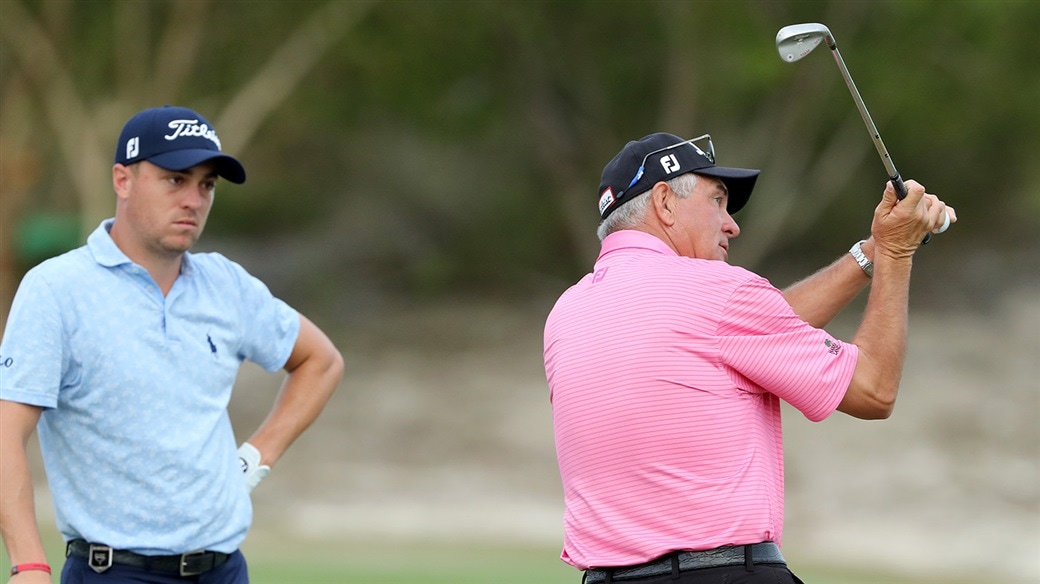
Q: What is the danger if Justin’s swing gets too long?
Mike: When Justin gets long his contact suffers some, and therefore his direction also suffers. We usually address long with width of swing. The wider his arc is going back the less likely he gets long. Also as his turn stops his arms continue on which we talk about some times. Most amateurs that are "long" are actually "narrow" at the top. Their arms are too close to their body. If their arms were farther from their body at the top they would stop sooner.
Q: You mentioned the importance of Justin’s swing staying on plane. Why is it important to swing on-plane?
Mike: Pretty simply put, the ball is sitting at the bottom of an arc. Picture a tilted hula hoop or those big swing plane devices. The ball sits at the bottom of that tilted plane or arc. If you get off that arc, or plane, you are going to have to compensate somehow to get the ball to go where you intend. That compensation is hard to time up or repeat consistently. Regardless of whether a player is on-plane or on-path going back, the best ball strikers are on-plane approaching impact.
Q: Justin hit some unique shots at TPC Sawgrass (his sweeping low draw with a fairway metal off No. 18 tee comes to mind). Has he always liked to work the ball like that or has it taken a while for his confidence to grow to the point here he's comfortable attempting shots like that under tournament pressure?
Mike: He's done that since he was six years old. So he doesn't think twice about doing it on a big stage. We always hit a lot of shots with imagination, so it is second nature to him.
 Q: Justin isn't a big guy, but he possesses amazing power. Is it all natural ability or did you train for speed? Did your approach in teaching him evolve from the way kids were taught a generation earlier?
Q: Justin isn't a big guy, but he possesses amazing power. Is it all natural ability or did you train for speed? Did your approach in teaching him evolve from the way kids were taught a generation earlier?
Mike: He was a tiny kid until about 16-17 years old, and he didn't get strong until college. Because he was so small, he swung as hard as he could every time. That is why his feet come off the ground today. Young kids try to generate a lot of power and that usually involves using the ground (by accident in his case). I didn't know at the time how to train for speed, I just know you will maximize your distance by hitting the ball in the center of the club, which is often overlooked as a distance factor. And yes, my teaching has evolved as I have been around other coaches the past thirty years, but I still keep things really simple, and never teach any type of "model" swing.
Q: Do you have a go-to tip for amateurs who want to hit it farther?
Mike: Center contact is first. There isn't one "go to" tip, but it isn't hard to watch a student and see where their distance loss comes from. It's different with each person, but if they're not hitting it in the center of the club, they won't optimize what they already have.
Q: What are some other strengths that you admire in Justin's game?
Mike: His ball striking is his biggest asset. His short game imagination is wonderful. The biggest growth in his game has been his level of patience has gotten better and better. It's a long four days, and one hole, or one bogey can't derail your week.
 Q: When we see you on the range at PGA TOUR events, you're frequently in a semi-catcher's-squat, taking video of Justin's swing on your phone. Are there specific positions in the swing or mechanics that you're regularly monitoring?
Q: When we see you on the range at PGA TOUR events, you're frequently in a semi-catcher's-squat, taking video of Justin's swing on your phone. Are there specific positions in the swing or mechanics that you're regularly monitoring?
Mike: HAHA, I get grief for that all the time. I just have to get low enough so that the camera is on his hand and down the target line. From face on, I don't have to get as low. Every video has to be taken from the same angle so if we compare one picture or video to another from any point in time, we are making a fair comparison. If the camera angles are different you can't compare them.
Q: What days of the week are you typically at Tour events with Justin? Do you have a Tuesday-through-Thursday routine, or is it more fluid, depending on what's needed? Does your schedule change during major weeks?
Mike: We don't change anything for a major, we have a routine and we stay with it. Since I left my club in Kentucky, I am out all weeks he is. I used to come home Wednesday after we got our work in and go back to the club, but now I stay all week. Our routine is typically a very light day, if anything on Monday. Tuesday is the big work day where we touch every part of his game, and typically play nine holes. By Wednesday we should have things dialed in, and there is usually a pro-am, and after the pro-am we will lightly work on anything that needs attention from playing that day. But by Wednesday, we should be set to go, it is too late at that point to be working on things!
Q: During the Tour season, how do you balance swing mechanics and issues with technique vs. preparing Justin to compete with what he has to work with that week? Is your job more coach than teacher during the season?
Mike: I feel like all my students get part teacher, part coach. It's an important part of what we do. As we have always kept things simple, and are always monitoring the few places he is likely to get off track, it is pretty easy to pull Justin back to where we want to be. We have typically done some work a few days at home leading up to an event, so we know where we are, and what needs to happen on site. If we haven't come all the way to where we want to be, we continue that work, but if we are in pretty good shape, we make sure most of our practice is performance-related to keep the practice focused. Performance practice would include things like chipping or putting drills & contests, iron and wedge combines on Trackman, etc. We like most of our practice on any given day to have a lot of performance aspects to them, where a score is always attached to your practice result.
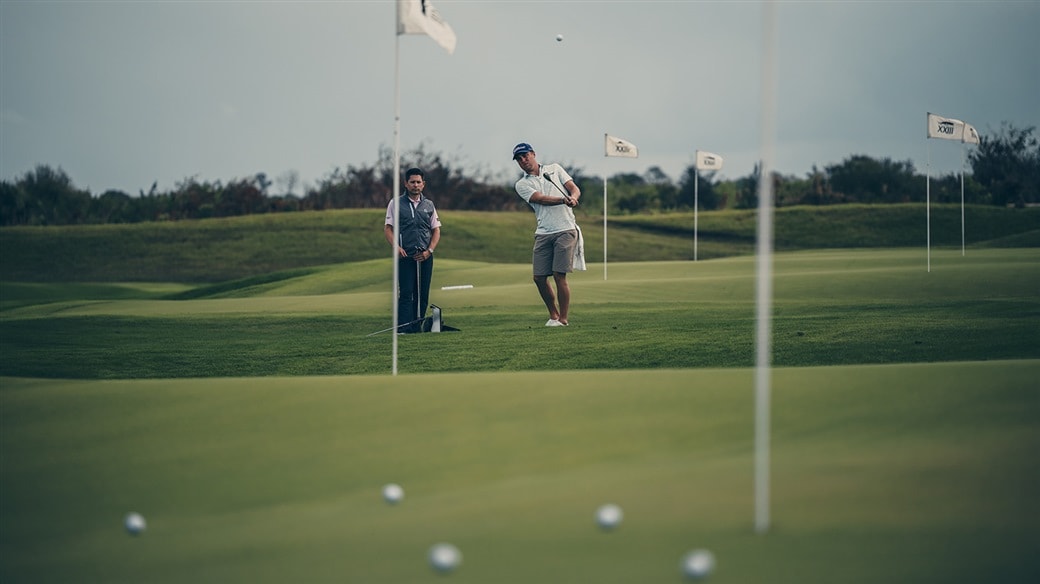
Q: What percentage of Justin's practice time do you dedicate to putting and short game?
Mike: I would say we are 70% short game (putting, chipping, bunkers, and pitching) and 30% long game. This would only change if we were really hitting it poorly, which fortunately doesn't happen often.
Q: Do you like to incorporate newer technologies into your teaching, like launch monitor data, force plates, etc.?
Mike: I used video platforms a long time before they were popular. When I was a club pro, and teaching a lot, most of today's technology had not been developed. As launch monitors, etc. became available, I could never justify the expense., as teaching was only part of what I did at the club. But we certainly use all these things now. They are very beneficial tools for checks and balances.
Q: What other types of professionals do you and Justin employ as part of his performance team and how do you coordinate and collaborate with those various experts? (physical trainers, mental game experts, Titleist Tour Van equipment experts and fitters, etc.)
Mike: John Graham is Justin's putting coach. There will be physios and trainers at every event that service multiple players, and those players all split the cost of having them on site. The Titleist Tour Van team is an invaluable part of the traveling team. Neither Justin nor I are what I would call equipment "geeks". That just never interested either of us. So, we rely on the expertise of the Titleist Team, and have total trust in what they provide us. Those guys do some serious travel and work some long hours, we have a huge appreciation for their dedication to Justin.
Q: Do you teach tour players and amateurs any differently?
Mike: No. The golf ball doesn't know who's hitting it. The ball can only respond to the motion leading up to impact. Regardless of the level of player, you look at their ball flight, and see what they are doing to cause that ball flight, and incorporate methods, drills, etc., to alter the motion. That aspect of teaching doesn't change between the average golfer and a tour player.
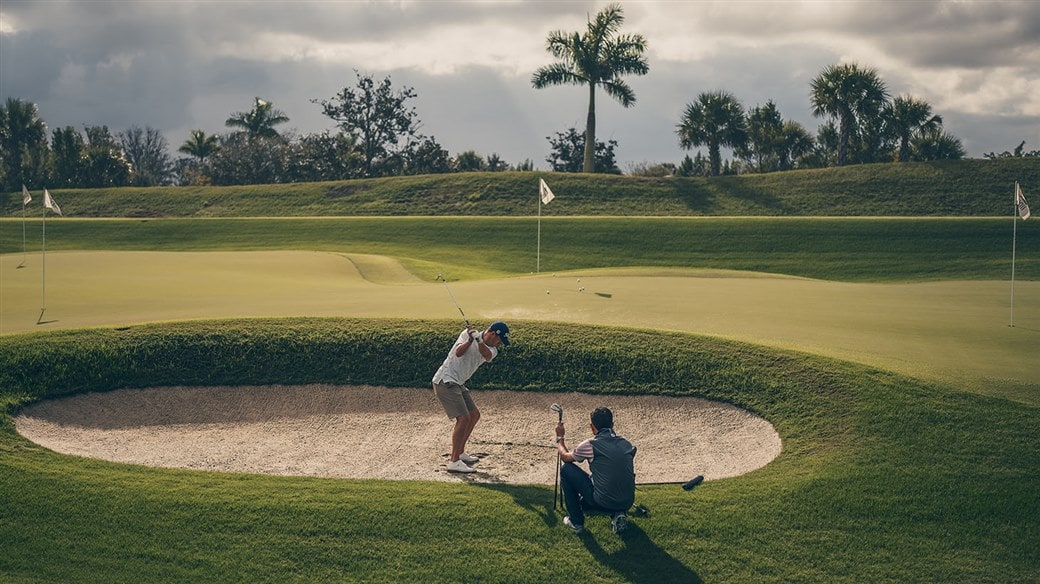
Q: In your experience, is there one skill or talent that separates tour players from amateurs?
Mike: I don't think just ONE SKILL can separate an amateur from a tour player. Tour players hit it a lot more solid, a lot more often, hit it much straighter, putt and chip it much better, are better bunker players, etc etc. But, that being said, the overwhelming difference I see and preach to my students is the amount of time tour players work on their game from 80 yards and in, vs. the average golfer who seldom works on that part of their game.
Amateurs should focus A LOT MORE TIME, on the game from 80 yards and in. Amateurs generally are poor pitchers, chippers and putters, or nowhere near where they could be with some effort. Also, all of the young players I teach that are competing in tournaments etc, – we stress the importance of performance practice, where every activity you do in practice has a score attached to it. This makes you practice time more efficient, more focused, and the scores don't lie. We want all our practice to replicate actual on-course performance.
Click here for some of Mike and Justin's performance-related drills that you can use to make your practice time more productive.
Q: What can amateurs learn from tour players? What should they NOT pay attention to or try to emulate?
Mike: What amateurs never seem to learn from tour players is the massive amount of time they spend on their short games. It is crazy how little amateurs practice in this area, and it is the one area where, regardless of skill level, they could make huge improvements. What they shouldn't do is try to emulate any given players action. These players are usually in excellent shape, train hard, practice hard, and that is why they can do the things they do. Someone who is never in the gym, doesn't practice much, and whose body type or build may not even be close to a player, can't do the same things.
Q: Does the approach change when you come into a big tournament as defending champion?
Mike: Nothing changes. We have the same routine every week, and we stay with that. Maybe the only thing that does change when defending is a little more media commitments etc, but we are accustomed to that, and plan around it.
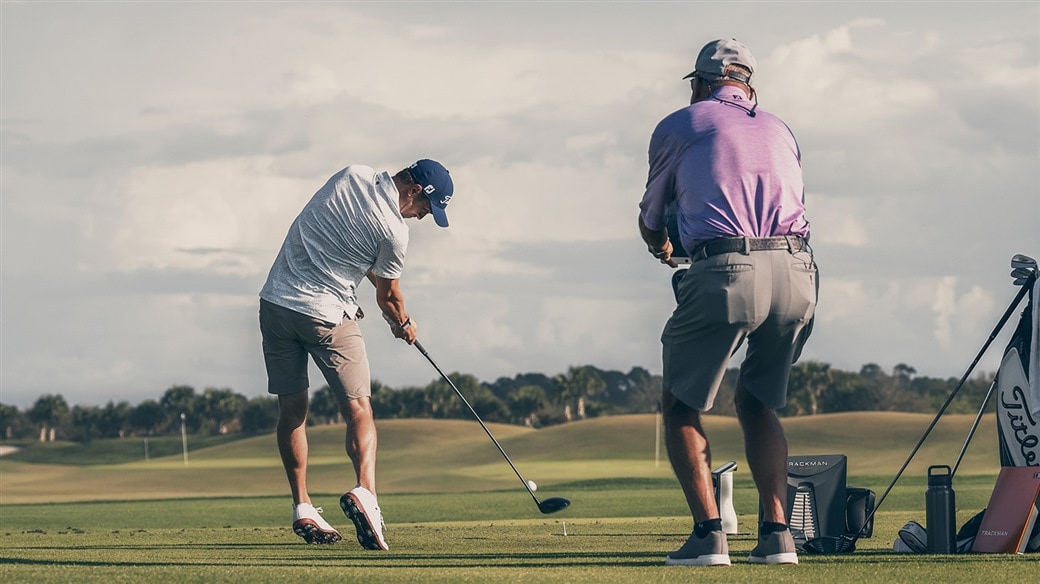
Q: Finally, not sure if this is a great question or the worst you've ever had to answer – In golf do you hit the ball? Or do you swing and let the ball get in the way?
Mike: Good question, actually. You swing and the ball gets in the way. Good players are target-conscious. They make a motion and the ball gets in the way. Average golfers are ball-conscious, and they hit AT the ball, vs at the target. An example I often point out to some students is when tour players address the ball, they stare at the target and glance at the ball,. The average golfer stares at the ball, and glances at the target. As stated earlier, I don't really have a swing model, or method. I always try to work with what that student has, taking into account how much they play, how much they practice, what their goals are, etc. Also important are any physical limitations they may have, such as back issues, flexibility, etc. That being said, I am a huge fan of focusing on the path of the swing, or plane, and the club face. The golf ball gets its instructions on what to do at impact, and that impact is improved as the club gets on or close to a correct plane, with the club face oriented squarely to the target. The farther off either of these conditions are, the farther off-line your golf ball will fly, and the more your contact will suffer.
Thanks for the great insights, Mike. Best of luck to you and Justin at THE PLAYERS and throughout the rest of the season!
Want to learn more from Mike and other world-class golf instructors? Visit the TItleist Instruction Center.
More Coach/Player Stories:
Mark Blackburn and Max Homa: Inside the Coach/Player Partnership
#TeamTitleist